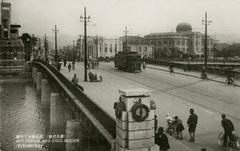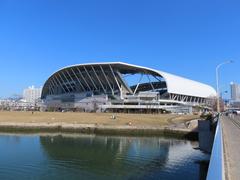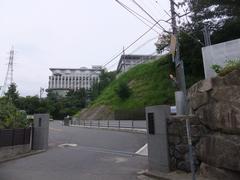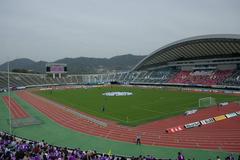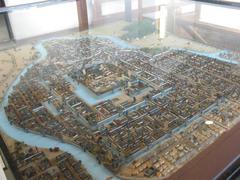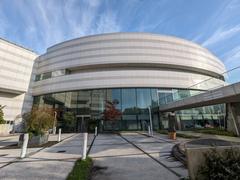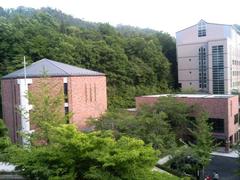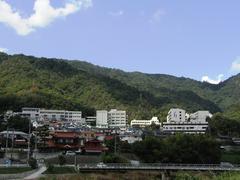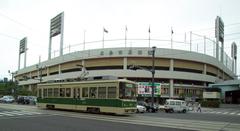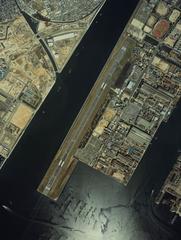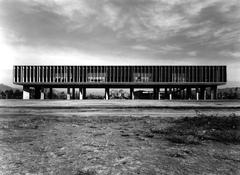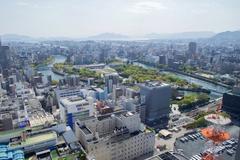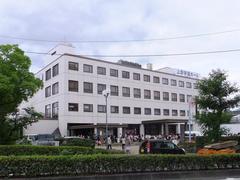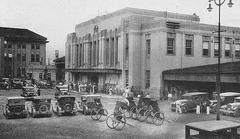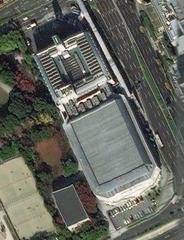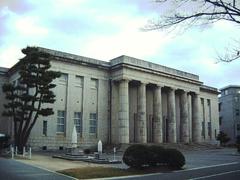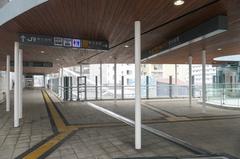
Hiroshima Detention House Visiting Hours, Tickets, and Tourist Guide
Date: 03/07/2025
Introduction to Hiroshima Detention House and Its Historical Significance
Hiroshima, a city renowned for its message of peace and resilience, is home to many historical landmarks beyond its famous memorials and museums. Among these is the Hiroshima Detention House (広島拘置所, Hiroshima Kōchisho), a critical correctional facility located in Hiroshima’s Naka-ku district. While often overlooked by tourists due to its restricted access, the detention house plays an essential role in Japan’s penal system. It functions primarily as a holding center for pre-trial inmates and is one of only seven facilities in Japan authorized to carry out executions. Established in the mid-20th century, its presence reflects the evolution of Japan’s legal and correctional practices from the Edo period to the present day (PrisonsOnline; Wikipedia).
Although entry to the detention house is restricted, its exterior features a culturally significant mural that offers a glimpse into Hiroshima’s castle town heritage. This unique juxtaposition of solemn correctional function and vibrant public art invites visitors to reflect on the city’s complex, layered history.
This guide provides a comprehensive overview of the Hiroshima Detention House’s historical context, cultural relevance, visitor information, and tips for exploring the surrounding heritage sites.
Table of Contents
- Introduction
- Historical Development of Hiroshima Detention House
- Visitor Information and Public Access
- The Execution Chamber: History, Tours, and Visitor Information
- Hiroshima Detention House Mural: Visiting Hours, Tickets & Historical Significance
- Visiting Hiroshima Detention House: Hours, Access, and Its Role in Hiroshima’s Peace History
- Conclusion
- Sources and Further Reading
Historical Development of Hiroshima Detention House
Origins and Early History
Japan’s penal institutions date back to the Edo period (1603–1868), when they served mainly as holding facilities for political prisoners and those awaiting trial. Conditions were harsh and facilities lacked proper sanitation and healthcare (PrisonsOnline). The Meiji Restoration (1868–1912) ushered in significant reforms, modernizing the legal and penal system. The establishment of the first modern prison, Fuchu Prison, in 1871, marked a new era for correctional practices in Japan.
Integration into the National Penal System
Japan’s correctional infrastructure is composed of prisons, detention houses, and juvenile facilities. The Hiroshima Detention House is one of ten such facilities, primarily holding pre-trial inmates, but also housing death row prisoners and serving as an execution site (Wikipedia). The Correction Bureau of the Ministry of Justice manages these institutions, ensuring the classification and treatment of inmates according to strict standards (Ministry of Justice).
Role as an Execution Site
A defining aspect of the Hiroshima Detention House is its status as one of Japan’s seven execution chambers (Wikipedia). Executions in Japan are carried out by hanging and are conducted with complete secrecy. The presence of an execution chamber highlights the facility’s importance within the national penal system.
Visitor Information and Public Access
The Hiroshima Detention House is not open to the general public. There are no regular visiting hours or ticketing options. Access is restricted to legal representatives, family members of inmates, and official personnel. On rare occasions, special guided tours or educational visits may be arranged by the Ministry of Justice or local authorities, but these require advance approval.
For those interested in Hiroshima’s history, nearby public sites such as the Peace Memorial Park, Hiroshima Castle, and Shukkei-en Garden provide accessible and meaningful opportunities to learn about the city’s past (dive-hiroshima.com; Japan Travel; Hiroshima Prefecture).
The Execution Chamber: History, Significance, and Visitor Information
Historical Background
The execution chamber at Hiroshima Detention House is one of only seven in Japan. While capital punishment remains a part of Japan’s justice system, its implementation is rare and shrouded in secrecy (Wikipedia). The chamber’s existence is a subject of ongoing ethical debate and reflection in Japanese society.
Cultural Significance
The detention house, and especially its execution chamber, serves as a place of solemnity and ethical reflection. It symbolizes the intersection of justice, human rights, and societal order, making it a significant touchpoint for those studying Japan’s legal and cultural evolution.
Visitor Details
Visiting Hours & Tickets
- Public Access: General public access is not permitted. There are no regular visiting hours or ticket sales.
- Special Tours: Rarely, special educational tours may be organized. Details can be obtained by contacting the facility or local tourist information offices.
Travel Tips
- The facility is centrally located and easily accessible by public transportation.
- If you are part of an approved tour, bring identification and adhere strictly to security protocols.
- Photography and recording are prohibited within the facility.
Accessibility
- The surrounding area is pedestrian-friendly.
- Facility access for those with disabilities is possible only during authorized visits; inquire ahead for details.
Special Events and Guided Tours
Occasionally, the detention house collaborates with educational institutions or legal organizations for special tours or lectures. These are strictly controlled and require advance registration.
Related Attractions
- Hiroshima Peace Memorial Park
- Hiroshima Castle
- Shukkei-en Garden
Visuals and Media
Images of the facility’s exterior and mural may be viewed from public areas, but internal visuals are not available due to privacy and security reasons.
Hiroshima Detention House Mural: Visiting Hours, Tickets & Historical Significance
Introduction
The Hiroshima Detention House mural is a major public artwork commissioned to commemorate the 400th anniversary of Hiroshima Castle. Painted by Irino Tadayoshi in 1989, the mural offers a vivid window into the city’s Edo-period heritage (dive-hiroshima.com).
Historical Background and Location
Located close to Hiroshima Castle, the detention house stands on historically significant ground once occupied by samurai residences (dive-hiroshima.com). The mural’s setting bridges the city’s feudal past and modern present.
Creation and Restoration
The mural stretches approximately 2 meters high and 180 meters long, making it one of the most extensive public artworks in Hiroshima. It underwent a major restoration from 2009 to 2013 to preserve its historical and artistic integrity (dive-hiroshima.com).
Artistic Features and Symbolism
The mural depicts lively castle town scenes with samurai, merchants, and townspeople, employing traditional Japanese painting techniques. It serves as a visual bridge between Hiroshima’s historical identity and contemporary life.
Cultural Significance
- Commemoration and Education: The mural compensates for the loss of historical architecture during WWII, providing a visual narrative of Hiroshima’s past.
- Artistic Dialogue: It contributes to Hiroshima’s peace identity, echoing themes of resilience and community found in other public art projects (triptojapan.com).
- Community Engagement: The mural’s creation and restoration involved local artists and artisans.
Visiting Information
Location and Accessibility
- Address: 2-6 Kamehatchobori, Naka-ku, Hiroshima City.
- Accessibility: The mural is on the exterior wall and can be viewed from public spaces.
Visiting Hours and Tickets
- Hours: The mural can be viewed any time, though daylight hours are best.
- Tickets: No admission or tickets required.
Transport Options
- Tram: Hiroden Kamiyacho-nishi or Kamiya-cho-higashi stops (10-minute walk).
- Bus: Several city bus lines serve the area.
- On Foot: Easily combined with a tour of Hiroshima Castle.
Viewing Tips
- Visit during daylight for best visibility.
- Photography is allowed from public spaces.
- The mural is included in some local historical walking tours.
Nearby Attractions
- Hiroshima Castle
- Shukkei-en Garden
- Peace Memorial Park (explorecity.life)
Role in Hiroshima’s Art Scene
The mural is part of a vibrant local art scene, including:
- Peace Boulevard murals
- Naka-ku public art projects
- Hiroshima Prefectural Art Museum (triptojapan.com)
Multimedia Tips
Consider high-quality images and maps to enhance your visit. Virtual tours of nearby sites are available through official tourism websites.
FAQ
Q: Can I enter the detention house to see the mural?
A: No. The mural is visible from the street; entry is not permitted.
Q: Are there any fees?
A: No, it is free to view from public areas.
Q: Is photography allowed?
A: Yes, from public spaces.
Visiting Hiroshima Detention House: Hours, Access, and Its Role in Hiroshima’s Peace History
Location and Accessibility
Located in Higashi-ku, approximately 2 km northeast of Hiroshima Station, the detention house is accessible via tram and bus. The area is pedestrian-friendly and close to major landmarks (Japan Travel).
Visiting Hours and Ticketing
- General Public: No regular hours or ticketing for tourists.
- Special Tours: Occasionally available via application to the Ministry of Justice.
Travel Tips
- Confirm any rare access opportunities in advance.
- Bring ID for official visits.
- Most signage is in Japanese; consider a guide if needed.
Nearby Historical Sites
- Hiroshima Castle
- Shukkei-en Garden
- Hiroshima Prefectural Art Museum
Hiroshima Detention House and the City’s Peace Narrative
Although not a memorial, the detention house symbolizes the coexistence of justice and peace in Hiroshima’s modern society. Its ongoing operation illustrates the city’s resilience and the importance of law and order alongside peace advocacy (Hiroshima Prefecture).
Frequently Asked Questions (FAQs)
Q: Can tourists visit the Hiroshima Detention House?
A: No, except for rare special tours.
Q: Are there guided tours?
A: Occasionally, with advance application.
Q: Is photography allowed?
A: Only the exterior and mural from public spaces.
Q: What’s nearby to visit?
A: Hiroshima Castle, Shukkei-en Garden, and the Prefectural Art Museum.
Conclusion
The Hiroshima Detention House is an important but little-known part of the city’s history, representing both the somber realities of justice and the vitality of community memory through its exterior mural. While direct access is generally restricted, the site’s mural and its proximity to major historical landmarks make it a valuable point of reflection for those interested in Hiroshima’s complex narrative of peace, justice, and resilience. Respect site restrictions and use official resources to deepen your understanding of this unique heritage site.
For updates on Hiroshima’s cultural heritage, download the Audiala app and follow our social channels.
Useful Links
- Ministry of Justice Official Website
- Hiroshima Peace Memorial Museum
- Hiroshima Prefecture Peace Site
- Japan Travel: Hiroshima Guide
Summary and Recommendations
The Hiroshima Detention House is a poignant symbol in both Japan’s penal system and Hiroshima’s broader historical narrative. While public access is limited, the site’s historical significance, striking mural, and proximity to important landmarks like Hiroshima Castle and Shukkei-en Garden make it a meaningful stop for those interested in the city’s layered story. Respect operational restrictions, consult official resources for rare educational opportunities, and explore the public mural and nearby attractions for a rich and respectful experience (dive-hiroshima.com; Wikipedia; Japan Travel; Hiroshima Prefecture).
Sources and Further Reading
- Behind Bars in Japan: A Look Inside the Country’s Prison System – PrisonsOnline
- Penal system of Japan – Wikipedia
- Hiroshima Detention House – Wikipedia
- Ministry of Justice, Japan
- Discovering the Hiroshima Detention House Mural – dive-hiroshima.com
- Hiroshima’s Art Scene – triptojapan.com
- Japan Travel: Hiroshima Guide
- Hiroshima Prefecture Peace Site

